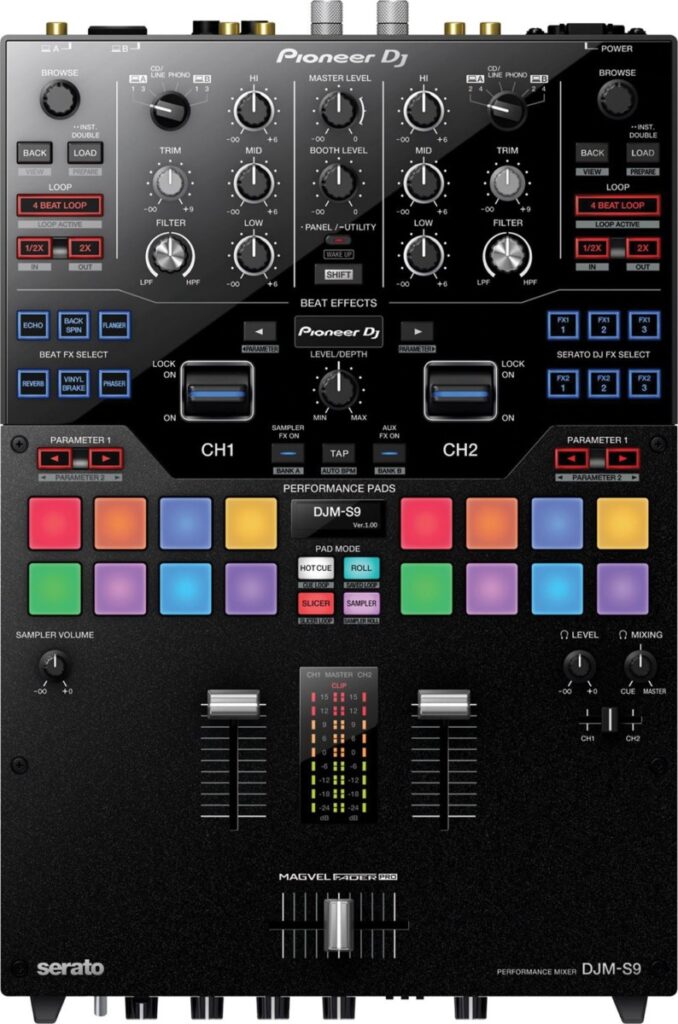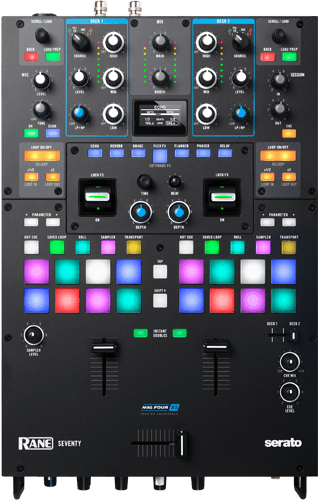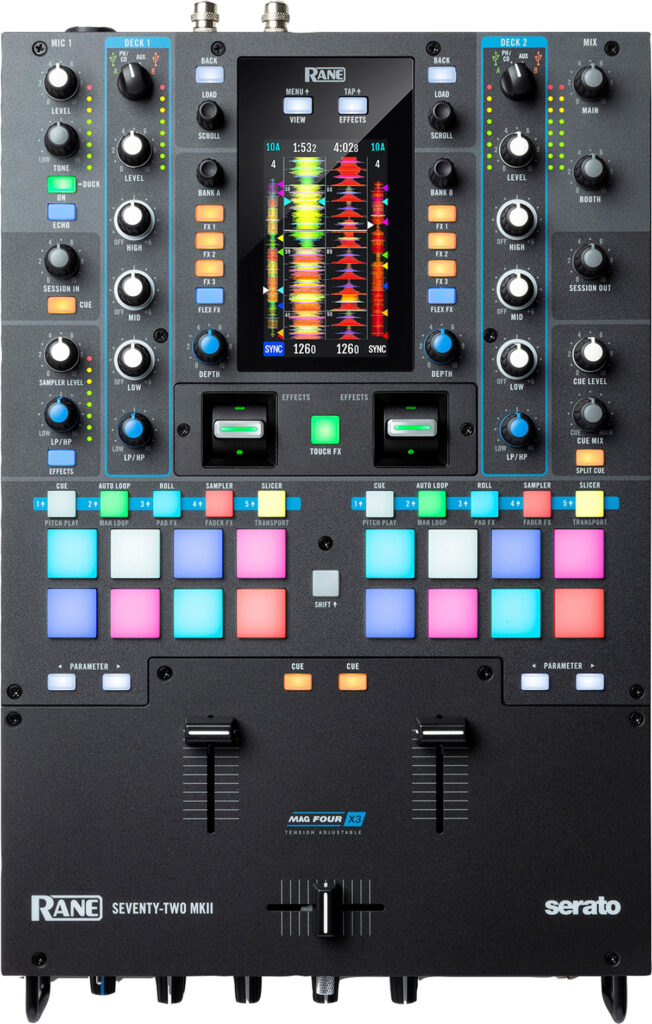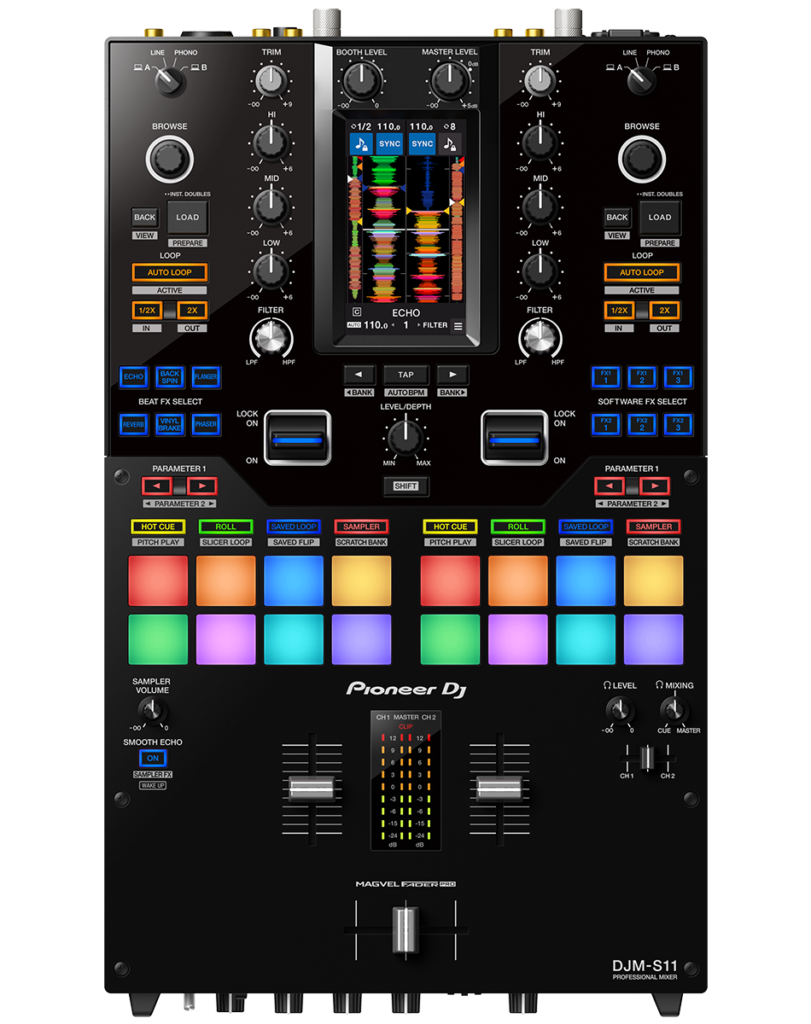
Update Dec 7, 2020: Scratch Bank for Rane mixers – requires Serato update
This has been an exciting year for DJ battle mixers. We have had three new 2-channel DJ battle mixers introduced this year (2020) by two of the leading DJ equipment manufacturers, Rane and Pioneer.
Rane Announcements
Earlier this year at NAMM, Rane announced their new Seventy 2-channel battle mixer. This was their update to its predecessor Sixty-Two mixer, and somewhat of an answer to the Pioneer DJM S9, which was introduced in 2014.
In August 2020, Rane dropped some new surprises with the announcement of the 2nd generation Rane Seventy-Two MK2 alongside their Twelve MK2 digital decks.
Pioneer Announcement
Then in early October of 2020, Pioneer announced the DJM S11. So far, this is the successor of the DJM S9, but it really stepped into a different category of touchscreen battle mixers alongside the Rane Seventy-Two.
Mixer Categories
Some are comparing the Pioneer DJM S11 with the Rane Seventy, but if we look at the categories (2-channel vs. touchscreen 2-channel DJ Software mixers), then the direct comparisons would be:
- 2 channel: Rane Seventy vs. Pioneer DJM S9
- Touchscreen 2 channel: Rane Seventy-Two vs. Pioneer DJM S11
What is Presented in this Review
As we go into this review, I will be presenting quantitative info based on the objective features in a comparison. Qualitative and subjective feedback like on sound quality without audio measuring tools, will have to be determined by your own ears or other reviewers. I would personally defer to sound measuring techniques and devices like spectrometers.
I have had first-hand experience with the Pioneer DJM S9, S11 and the Rane Seventy, so I have not experienced the Seventy-Two, but the info in this review will be based on their features and offerings as of November 24, 2020.
All of these mixers offer DJ Software support and MIDI, so we can assume that all of these can be customized with MIDI mapping to an extent, but this review will highlight the out-of-the-box settings.
2-Channel Battle Mixers
Pioneer DJM S9

We will start first with the Pioneer DJM S9, even though it is not new, I would consider it in the same category and one of today’s direct competitors to the new Rane Seventy. This mixer was originally introduced around 2014 and this overview will be brief, but I believe it is important to note as we get into reviewing the newly released mixers.
It was Pioneer’s answer to modern DJ Software mixers like the Rane Sixty-Two which was introduced around 2012. Even though it is over 6 years old, it has proven itself to be a viable contender even in today’s standards. However, being that old, it is obviously showing its age and in the technology world, that age comes with limitations. Even with flexibility of some customized MIDI mapping, that mapping can sometimes be limited by the hardware and design at that time, which may not have considered or had the ability to scale.
If you’re using the more common features of a DJ Software system, this mixer is still solid and will serve most Turntablists’/DJ’s common needs.
This came in around $1,699, but you can find used models for less than $1,000 now.
PioneerDJ.com (it’s still on their website, so that’s a good sign)
Pros
- Large pads
- MagVel faders
- Cross Fader tension control
- Clean & stylish aesthetics
Cons
- Pad modes are not independent per channel
- Lacks Split Cue
- Paint wear on the fader plate
- Some plastic components (cover plate and body)
- Common complaints about low XLR output & poor sound quality
- Common complaints about Volume fader bugs
- 6+ years old
Wish List
- Independent pad modes
- More firmware updates to keep it in the running
- More flexible MIDI mapping options
- Higher quality XLR outputs
Rane Seventy

Rane’s answer to the Pioneer DJM S9 and successor of the Sixty-Two, was released mid summer of this year, 2020. At first-glance, it shares a lot of similarities to the DJM S9 and Seventy-Two, such as the FX paddles, larger pads, and cross fader tension knob. But it does take a step forward with the introduction of independent pad modes, and several other features borrowed from its cousin, the Seventy-Two.
Although this doesn’t have a touchscreen, the small LED display does offer access to onboard settings and customizations from fader parameters, effects configurations, control mappings, such as changing the Instant Doubles buttons to Silent Cue mode and more.
The Seventy is what most DJ’s wish the S9 was, and a little more. The additional features and hardware controls allow for so many customizations to suit a variety of workflows and styles. The controls really took into account some good information architecture to group and present controls in an intuitive and smart layout, not only for visual organization, but for actual physical access and usage.
This comes in at a retail price of $1,499.
Purchase at Mile High DJ Supply
Update Dec 7, 2020
- Scratch Bank now available for new Rane mixers!
Pros
- Large Pads
- New MagFour faders
- Independent pad modes
- Split Cue
- Switchable Line/Phono Inputs
- Session I/O w Cue
- Solid steel construction
- 2 TRS mic inputs
- Dedicated configurable Instant Doubles buttons
Cons
- Hardly any – just didn’t really push the boundaries with the technology and software integration
Wishlist
TBH, I don’t have many for this mixer
- Color changes on the Instant Double buttons pending on selected mode (Instant Doubles vs. Silent Cue, etc.)
- Maybe split-pad/combo pad mode, which might be coming in the future and it’s not a deal breaker in my book
Touchscreen 2 Channel Battle Mixers
Rane Seventy-Two MKII

The Seventy-Two MKII is Rane’s latest flagship mixer. It is the second generation of the Seventy-Two which was originally introduced around March 2018. The MKII introduces some small updates with hardware and software including 3 x new MagFour faders, cross fader tension adjustment knob, updated knob color scheme, page independent remapping abilities for parameter buttons, updated effects engine, day mode on the touchscreen, but overall the Seventy-Two MKII has retained most of what its predecessor has.
The touchscreen allows for a variety of other features such as touch effects, onboard settings & customizations, and the obvious browsing and waveform display. The touchscreen offers a lot for effects such as customizations and configurations in addition to Effects Stacking, where you can have up to 6 effects per deck.
The Seventy-two has had a great layout of controls and still offers the Source, Level, 3 band EQ and Filter knobs conveniently inline per channel. You can also use the 8 pads for Pad FX among other customizations.
The Seventy-Two also has support for foot switch if you prefer to add effects via convenient pedals.
This comes in around $1,899.
Purchase at Mile High DJ Supply
Update Dec 7, 2020
- Scratch Bank now available for new Rane mixers!
Pros
- Full-color multi-touchscreen
- Day mode
- Updated effects engine
- Large pads
- Effects stacking
- New MagFour Faders
- Independent pad modes
- Switchable Line/Phono Inputs
- Split Cue
- Session I/O w Cue
- Solid steel construction
- Dedicated Sampler Filter and Effects
- Foot Switch
- 2 TRS mic inputs
- Deck Swap
Cons
- Minimal changes from its predecessor
- Didn’t really push the boundaries with its available technology
Wishlist
- I was expecting some larger changes from its predecessor
- More flex hardware controls for custom MIDI mapping
- Again, I really wish Rane would have reimagined new possibilities and features considering this has a full-color multi-touch screen and practically a small internal computer that integrates with DJ software
Pioneer DJM S11

This is Pioneer’s latest flagship battle mixer. Some consider it the successor fo the DJM S9, but it is in a different category of touchscreen DJ Software battle mixers now.
The DJM S11 improved upon many features and some issues that the S9 had, such as new independent pad modes per channel, more durable paint on the faded cover plate, suggested improvements to the sound hardware and outputs and new Enhanced MagVel Pro faders.
The layout below the screen is very familiar to the S9. The 3 band EQ knobs are now inline per channel, and the Load buttons are larger than the “back” buttons (the Scroll knob can now be custom MIDI-mapped for Load on-push if desired).
I’m going to expand on the S11 review, because they have introduced some new features that don’t exist on some of the other mixers and I felt they really did take some extra effort to push the boundaries of the technology they were working with, while still making it familiar.
There is the obvious new LED full-color touchscreen (single gesture), which opens a lot of new opportunities and features, including Touch Effects and 4 Deck mode!
4 Deck Mode
4 Deck mode offers 2 virtual decks (3-4) that can be enabled and controlled through the screen or other MIDI devices. Not only do you have 2 other virtual decks, but you can also use Deck Move to move tracks between any of the 4 decks. Then you have Mashup mode where you can actually lock the virtual deck (i.e. deck 3) with the real deck (i.e. deck 1), allowing you to control both decks with your physical deck 1.
Smooth Echo
This a whole new feature not found on any of the other mixers. Some would argue that this is very similar to Ducking Echo found on others, but it does offer some other features that are more unique, including customized trigger mechanisms like Load, Hot Cue, in addition to the Faders. You can also adjust the period that will trigger the Echo, which is helpful for scratching routines, where you can control the echo based on how long you have the fader open.
Split-Pad Mode
You can also use the pads in 2 modes per channel. This means you can use the top 4 pads in a mode like Hot Cue, and the bottom 4 in another mode like, Sampler. This is possibly a feature that might make it to other mixers. 🤞
Scratch Bank
Update Dec 7, 2020 – Scratch Bank now available for Rane 70 & 72 MkII mixers!
This is unique to the Pioneer S11. This is a dedicated bank for scratch samples, but can extend into other use cases. It is similar to the Serato Sampler, but instead of just playing the sample from the bank, it actually loads the track into the deck. You can even designate it to load at the desired cue point. On top of that, you can hold shift+the sample, and this will unload the scratch track and reload the previous track you had making it quick and convenient to go between scratching and your main track. Technically, you could do something like this without Scratch Bank by essentially having a Crate for scratch tracks and load, then you could “undo” and it will take you back to the previously loaded track.
There were reports that this was available in Serato before the S11 was announced but after an update, it was removed and only enabled with an S11. It may be proprietary and might not make it to other mixers.
The S11 comes in at $1999 and $2099 for the limited SE model (to 1500 units) that pays homage to the old 909 with similar striped graphics, orange loading screen and limited edition orange Serato DVS records.
Purchase at Mile High DJ Supply
Pros
- Bright touchscreen (fast refresh rate)
- Enhanced MagVel Pro faders
- Improved control layout
- Independent pad modes
- 2 USB buses for other devices
- Split pad mode
- Smooth Echo
- Dedicated Scratch Bank Mode (This feature is now available on Rane mixers)
- 4 Deck mode
- rekordbox support
Cons
- Plastic body parts
- Plastic effects paddles
- Only 1 TRS Mic input
- No Split Cue
- Limited amount of hardware controls for custom mapping
- Most expensive of the 4 mixers
Wishlist
- Less plastic, but I never had any issues with those parts on the S9
- More flex hardware controls for custom MIDI mapping – like physical Silent Cue buttons
- Channel independent effect depth knobs
- Dedicated Effects control for Sampler (instead of Shift+ Smooth Echo button)
- Cue for Virtual Decks (3,4), Sampler, Aux and Mic
- Split Cue
- I never use a foot switch, but why not on a $1999 mixer?
Feature Comparison
| Feature | Pioneer DJM S9 | Rane 70 | Pioneer DJM S11 | Rane 72 MKII |
|---|---|---|---|---|
| Headphone Out | 1/4” & 3.5mm | 1/4” & 3.5mm | 1/4” & 3.5mm | 1/4” & 3.5mm |
| Faders | Magvel Fader Pro | MagFour | Enhanced Magvel Fader Pro | MagFour |
| Cross Fader Tension Control | ✅ Yes | ✅ Yes | ✅ Yes | ✅ Yes |
| Reverse controls Volume and Cross faders | ✅ Yes | ✅ Yes | ✅ Yes | ✅ Yes |
| Cut-in adjustments | ✅ Yes | ✅ Yes | ✅ Yes | ✅ Yes |
| Smooth Echo controls | 🚫 No | 🚫 | ✅ Yes | 🚫No |
| Sampler Volume Control | ✅ Yes | ✅ Yes | ✅ Yes | ✅ Yes |
| Sampler Filter Knob | 🚫 No | 🚫 No | 🚫No | ✅ Yes |
| Sampler Effects button | 🚫 No | 🚫 No | ✅ Yes | ✅ Yes |
| Cue | Mini fader | Mini fader | Mini fader | Cue Buttons |
| Split Cue | 🚫No | ✅ Yes | 🚫No | ✅ Yes |
| Parameter Buttons per channel | ✅ Yes | ✅ Yes | ✅ Yes | ✅ Yes |
| Instant Doubles | Double Press Load |
|
Double Press Load |
|
| Independent Pad Modes | 🚫 No | ✅ Yes | ✅ Yes | ✅ Yes |
| Pad Mode Controls | Not independent | per channel | per channel | per channel |
| Combo/Split Pad mode | 🚫 No | 🚫 No | ✅ Yes | 🚫 No |
| Scratch Bank | 🚫 No | ✅ Yes (as of Dec 7 ,2020) | ✅ Yes | ✅ Yes (as of Dec 7, 2020) |
| FX | 15 | Yes | 22 (some from 909) | Yes |
| FX Depth Knobs | 1 | 2 (1/channel) | 1 | 2 (1/channel) |
| FX Buttons (software/hardware) | ✅ Yes | ✅ Yes Yes | ✅ Yes | ✅ Yes |
| FX Buttons location |
|
centered |
|
|
| FX Paddles | ✅ Yes plastic | ✅ Yes metal | ✅ Yes plastic | ✅ Yes metal |
| Channel independent FX controls | 🚫No | ✅ Yes | 🚫No | ✅ Yes |
| Dedicated FX Tap Button | ✅ Yes | ✅ Yes | ✅ Yes | 🚫No |
| Dedicated Loop Control Buttons | ✅ Yes | ✅ Yes | ✅ Yes | 🚫 (screen) |
| 3 Band EQ Knobs | ✅ Yes | ✅ Yes | ✅ Yes | ✅ Yes |
| Channel Filter Knob | ✅ Yes | ✅ Yes | ✅ Yes | ✅ Yes |
| Scroll Knob | ✅ Yes | ✅ Yes | ✅ Yes | ✅ Yes |
| Load track | Dedicated Load Button | Scroll Knob Press |
|
Scroll Knob Press |
| Load Prep Buttons | Shift+Load | Dedicated Button | Shift+Load | 🚫 No |
| Back Button | ✅ Yes | ✅ Yes | ✅ Yes | ✅ Yes |
| Master volume | ✅ Yes | ✅ Yes | ✅ Yes | ✅ Yes |
| Booth volume | ✅ Yes | ✅ Yes | ✅ Yes | ✅ Yes |
| Channel Inputs | RCA Phono or Line | RCA Switchable Phone/Line or Aux | RCA Phono or Line | RCA Switchable Phone/Line or Aux |
| Session I/O | 🚫 No | ✅ Yes | 🚫 No | ✅ Yes |
| Session Cue | 🚫 No | ✅ Yes | 🚫 No | ✅ Yes |
| Mic 1 TRS input | ✅ Yes | ✅ Yes | ✅ Yes | ✅ Yes |
| Mic 1 ducking/echo | ✅ Yes | ✅ Yes | ✅ Yes | ✅ Yes |
| Mic 2 TRS input | 🚫 No | ✅ Yes | 🚫 No | ✅ Yes |
| Foot Switch | 🚫 No | 🚫 No | 🚫 No | ✅ Yes |
| Deck Swap | 🚫 No | 🚫 No | Kind of: (Deck Move within screen) | ✅ Yes |
| 2 x USB Inputs | 🚫No | ✅ Yes | ✅ Yes | ✅ Yes |
| LED screen | 2 (1 for Pads, 1 for settings & fx) | 1 for settings and fx info | NA | NA |
| Full Color Touchscreen | 🚫 No | 🚫 No | ✅ Yes | ✅ Yes |
| Multi-touchscreen | NA | NA | 🚫 No (use shift + gestures) | ✅ Yes |
| 4 Deck mode (2 virtual decks) | 🚫 No | 🚫 No | ✅ Yes | 🚫 No |
| weight | 4.6 kg | 5.6 kg / 12.3 lbs. | 5.2 kg | 5.6 kg / 12.3 lbs. |
| frequency range | 20-20000 Hz | 20 Hz to 20 kHz (± 0.2 dB) | 20-20000 Hz | No data |
| S/N Ratio USB | 107 dB |
|
|
|
| Sound card sample rate | 24 bit | 24 bit | 24 bit | 24 bit |
| Sound card frequency | 48 kHz | 48 kHz | 48 kHz | 48 kHz |
| Digital Signal Processing | no data | 32-bit, floating point, double precision | no data | 32-bit, floating point, double precision |
Summary
They are all great mixers, and offer unique features based on their category. You can’t really go wrong with any of them, but look at the features and see which one suits YOUR needs the best.
Do you need a touchscreen on your mixer? This was a question I had since the Seventy-Two came out, even though the Pioneer 909 had a single-color screen. I didn’t feel it was necessary, because I interpreted it as a feature that just mirrored what was on your laptop with Serato like the waveforms, browse list, etc. But now that I have a better understanding of what is offered in the touchscreens across Rane and Pioneer, it has convinced me otherwise. It actually serves more than just a mirrored display. The screen allows for new things like touch effects, robust onboard customizations and settings, digital controls that hardware simply wouldn’t allow for, and on the DJM S11, ability to utilize 2 more virtual decks for 4 deck mode. This doesn’t mean everyone needs one, but if you look at what is available, then it has more purpose and justification for those who would use those features.
The Pioneer DJM S9 is older, and the only thing I would say is that although it is still a solid mixer, if you’re looking to take advantage of the software integrations & newer technology features, then it may be on its way out.
When deciding which one is right for you, consider the following:
- What type of DJ are you (purist, traditionalist, digital, turntablist/creative)?
- What type of media/music/styles do you commonly work with?
- What features do you need in a mixer today?
- What is your current setup not providing you?
- Is there another way to accomplish these features (via software, laptop, other devices)
- What features will you want or need in the near future?
- Look at your hardware needs first. Other than faders and knobs, hardware will not get upgrades or updates as easily as software & firmware.
- If you’re looking for a unique feature, how often would you use it?
- What is your budget?
About Me
I’m no DMC contender or champion, or the best DJ around. I simply love music & DJ’ing and have been doing it for longer than I want to say. I’m also a musician (guitarist) and have experience within audio/video production. I am a digital product designer that focuses on user experience. I work with, and enjoy “most” technology. The skills I use in my past times and career translate well into evaluating other products like mixers.
I have used a variety of mixers from the Vestax PMC 05, 06, 280, Rane 56, 57, Sixty-Two, Seventy, Pioneer DJM S9 and DJM S11. And some MIDI controllers along the way.
I was struggling on which mixer was right for me, so I performed some research to help me decide, and I felt this may help others.
Op Ed
None of these mixers will make you a better DJ. They do provide new technology and features that can help open doors and opportunities to new mixing & turntablism techniques that may take our art to the next level. We have already seen this evolve with DVS setups in the past 5-10 years and I only see this trend continuing with brands like Pioneer, Rane and Reloop paving the way.
Some DJ’s would argue (or already have) that some of these mixers or features are overkill for most DJ needs. Some would say these are ridiculous prices for features that are available by other existing means, but maybe with less “convenience.” This is “technology” though, it applies to many things, with instruments like electric guitars, synths, to devices like laptops and smartphones and even vehicles – the evolution to push boundaries and improve convenience is in the very nature of “technology” and not everyone has to adopt it.
These are new mixers for the DJ’s who would leverage the features available, hopefully take those features and expand the world of software DJing. If you are a purist, then some of these mixers may not be the right fit for you, and there is no problem with that. I love pure vinyl as well, and there’s a lot that no digital feature-loaded mixer can replace in that realm, but there’s no need to hate on others or on equipment just because it doesn’t fit your needs.
This is not a solicited review by any party mentioned in this post. I am not affiliated with Rane, Pioneer, any manufacturer or any retailer. I am suggesting you purchase your equipment at a small business like, Mile High DJ Supply, located in Colorado, who plays a large role in the DJ community including supporting the DMC Championships.